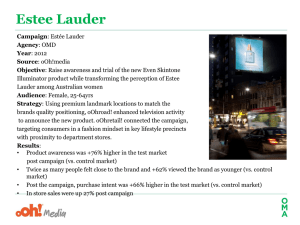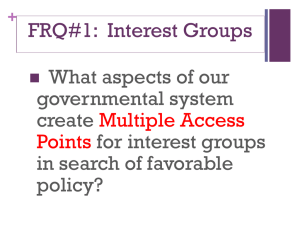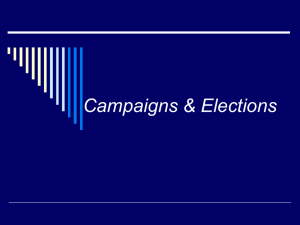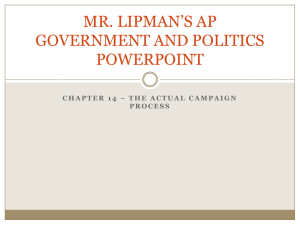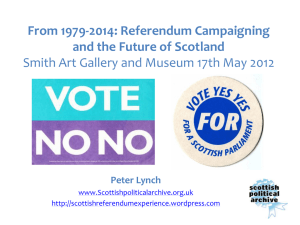Chapter 12
advertisement
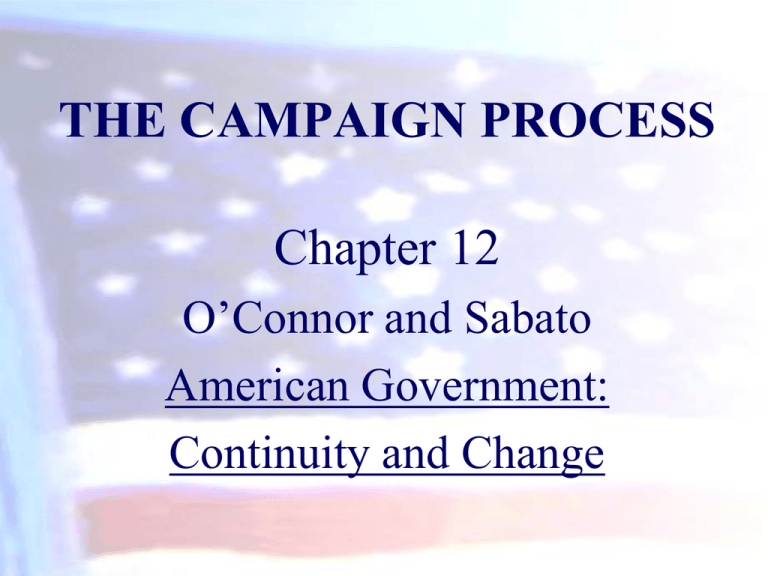
THE CAMPAIGN PROCESS Chapter 12 O’Connor and Sabato American Government: Continuity and Change THE CAMPAIGN PROCESS In this chapter we will cover… • The Structure of a Campaign • The Candidate or the Campaign: Which Do We Vote For? • Modern Campaign Challenges • Contributions and Expenses • Campaign Finance Laws The Structure of a Campaign All political campaigns can be viewed as a series of several campaigns that run simultaneously. The Nomination Campaign The General Election Campaign The Personal Campaign The Organizational Campaign The Media Campaign Do we vote for the Candidate or the Campaign? • The most important factor in any campaign is the candidate (he/she is even more important than money). • Campaigns are able (most of the time) to downplay a candidate’s weaknesses and emphasize her strengths. • However, even the best campaigns cannot put an ineffective candidate in the win column – most of the time. • Most people vote for a candidate not the campaign. Campaign Challenges The News Media Campaign Financing Televised Debates Individual Contributions Handling the Press? PAC Contributions Personal Contributions Party Contributions Contributions and Expenses • Campaigns are VERY expensive. • House races can cost over $1 million but usually cost $400-700,000 for incumbents, less for challengers. • Senate races cost much more. • All political money is regulated by the federal government under the Bipartisan Campaign Reform Act (2002), Formerly the Federal Election Campaign Act. Soft Money • Soft money is money with no limits or rules that is raised and spent outside of federal election guidelines. • Soft money is often used to pay for ads that do not expressly advocate the election or defeat of a particular candidate. • As long as these ads do not use the words "vote for", "elect", "vote against" or the like, ads can be paid for with unregulated soft money. • Many argue that the huge infusion of unregulated soft money has destroyed the federal campaign laws. BCRA - Individuals • FECA limits individuals to contributions of $2,400 per election, per candidate ($2,400 in the primary and another $2,400 in the general election). • Individuals are limited to a total of $115,500 in gifts to all candidates, political action committees, and parties combined per two yearyear election cycle. BCRA - PACs • PACs may donate $5,000 per candidate, per election. • There are over 4,000 PACs registered with the FEC. • PACs gave over $359 million to congressional candidates in 2006 (individuals gave $785 million). BCRA - Parties • National Parties can give up to $5,000 for a House member in the general election and $39,900 to a Senate candidate. • Wealthy members of Congress and state legislatures often also donate monies to candidates of their party. • Some members of Congress establish their own PACs to give money. Former Republican Speaker of the House, Newt Gingrich had a PAC. Personal Contributions • In Buckley v. Valeo (1976) the Supreme Court struck down limits on personal campaign spending. • Spending your own money on your campaign is a free speech right. • Steve Forbes, Ross Perot, and other wealthy Americans have taken advantage of their personal wealth in their quest for office.



